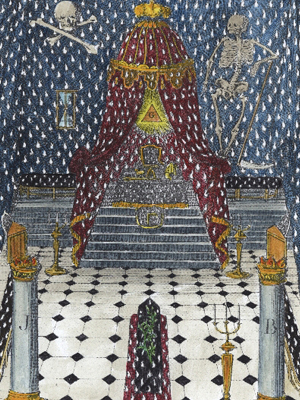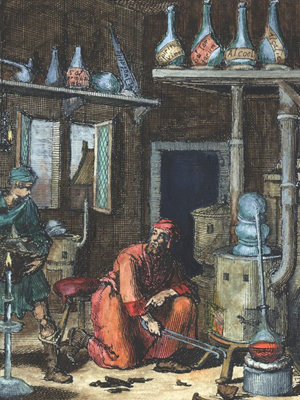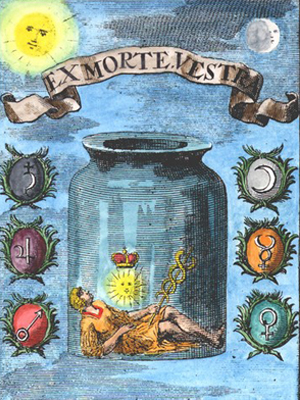Masonic Articles and Essays
The Alchemy of Masonic Initiation
Very Ills..... Bro... Pamela McDown 33o
Date Published:
10/30/2024
The Alchemists are the Ancient Brethren of the Freemasons. Can their mystic art shed light on the Wisdom of Freemasonry?
“The alchemists spent years in their laboratories, observing the fire that purified the metals. They spent so much time close to the fire that gradually they gave up the vanities of the world. They discovered that the purification of the metals had led to a purification of themselves.”
- Paulo Coelho, “The Alchemist”
 For some people, the word "alchemy" evokes the image of a bearded, slightly mysterious figure—a pseudo-scientist in a long, flowing robe—working in a dimly lit laboratory filled with strange glassware and bubbling potions. These alchemists did indeed exist in ancient times, their work being the forerunner of modern chemistry. Today, however, alchemy in its broadest sense, is a spiritual quest for one’s own gold or enlightenment.
For some people, the word "alchemy" evokes the image of a bearded, slightly mysterious figure—a pseudo-scientist in a long, flowing robe—working in a dimly lit laboratory filled with strange glassware and bubbling potions. These alchemists did indeed exist in ancient times, their work being the forerunner of modern chemistry. Today, however, alchemy in its broadest sense, is a spiritual quest for one’s own gold or enlightenment.
Both masonic scholars Brothers Manly P. Hall and Albert Pike agree there are more important dimensions to alchemy than purely material ones. Brother Hall goes so far as to say that Freemasonry and alchemy have so much in common that “nearly all of the masonic symbols are hermetic in character.” That is a striking statement!
A few commonalities come to mind. Both traditions are searching for that which is hidden or lost. In alchemy, it is the search for the hidden stone, or Philosopher’s Stone. In Freemasonry, it is the search for the lost word, or the Divine Name. Stones are a familiar metaphor to masons. The masonic candidate is symbolically an unrefined stone, shaped and polished through masonic teachings, ultimately becoming a "perfect ashlar" fit for the spiritual temple. It seems logical, on the surface, that the two traditions have similar themes, but does the similarity go even deeper?
In this article, we’ll delve into the fascinating correspondence between alchemy and Freemasonry. Does the alchemist's Great Work mirror the Freemason’s journey to moral and spiritual perfection?
The Emerald Tablet
“True, without falsehood, certain and most true, that which is above is as that which is below, and that which is below is as that which is above.”- Emerald Tablet
The Emerald Tablet of Hermes is regarded as a foundational text of alchemy. Though its exact origins remain obscure, it has been attributed to Hermes Trismegistus. The tablet is brief, yet its content is dense with wisdom, capturing the mysteries of how the planets and universe work in just a few lines. Most famously, it contains the axiom, "As above, so below” which is well known to the esoteric student. For the alchemist, the Tablet provides a guide to achieving the Great Work, the transmutation of base metals into gold, but also, more importantly, the transformation of the soul. The Tablet has received numerous translations and commentaries over time. My favorite version is here.
The difficulty of getting at the real importance of alchemical literature like the Emerald Tablet is the fact that there are three distinct groups of alchemical books. The first contains the works of the genuine adepts, who were in the lineage of the oral tradition of Hermetic Science. The second group consists of books written by people who misunderstood the writings of the true sages and thought they were only about purely physical processes and crude chemical experiments. The third group of books is written by quacks and imposters, who took advantage of the popularity of alchemy to line their pockets.
The Emerald Tablet I believe falls under the first class, written by genuine adepts. What can we learn from this ancient text?
Prima Materia and The Athanor
“Thou shalt separate the earth from the fire, the subtle from the gross, suavely, and with great ingenuity.” – Emerald Tablet
The starting point in alchemy, to separate the “earth from the fire” is working with the Prima Materia which is Latin for "First Matter." It is the original, formless substance that the alchemist seeks to purify and transform into its true essence. This produces the Philosopher's Stone, with the power not only to turn metals into gold but also to produce the Elixir of Life and spiritual enlightenment.
 Unfortunately, almost no two ancient alchemists can agree on what Prima Materia truly is. Does it actually have any real material substance such as one of the many elements that exist in all life as we know it? Or is it something less tangible such as energy, light or force? In true alchemical style — if these secrets are discovered by the alchemist — they are usually veiled in cryptic language and symbols. This means that as contemporary spiritual alchemists we are almost none the wiser about the true nature of Prima Materia. It remains a highly symbolic and elusive concept.
Unfortunately, almost no two ancient alchemists can agree on what Prima Materia truly is. Does it actually have any real material substance such as one of the many elements that exist in all life as we know it? Or is it something less tangible such as energy, light or force? In true alchemical style — if these secrets are discovered by the alchemist — they are usually veiled in cryptic language and symbols. This means that as contemporary spiritual alchemists we are almost none the wiser about the true nature of Prima Materia. It remains a highly symbolic and elusive concept.
Working with Prima Materia parallels the masonic candidate, who enters the Lodge in a state of darkness, symbolizing ignorance or unrefined potential. Just as the Prima Materia undergoes various stages of purification in the alchemical athanor—a furnace where the alchemist's work is conducted—the masonic initiate is subjected to a process of internal purification through the degrees. The athanor, which means "Essence of Fire," provides us with the instrument for the Great Work and transformations. In other words, the athanor is thought to be the human organism. We are reminded that One must have the Stone to make the Stone.
The French Esotericist Eliphas Levi says: "We are all in possession of the chemical instrument, the great and sole athanor which answers for the separation of the subtle from the gross and the fixed from the volatile.”
These thoughts beg the question. How does the mason really figure in? As the vessel or its operator? Or both? To explore further requires a look at the alchemical stages.
The Stages of the Alchemical Process and the Masonic Degrees
“It ascends from earth to heaven and descends again to earth and receives the power of the superiors and of the inferiors.” – Emerald Tablet
In alchemy, the Great Work is divided into three major stages: Nigredo (blackening), Albedo (whitening), and Rubedo (reddening). The Greek Philosopher Heraclitus of Ephesos (535 BC-475 BC) originally outlined four stages but one was eventually eliminated (the Citrinitas or yellowing stage).
The parallels between these three stages and the first three degrees of Freemasonry—the Entered Apprentice, Fellowcraft, and Master Mason—are compelling.
Nigredo and the Entered Apprentice Degree
Nigredo, or blackening, represents the stage of decomposition and dissolution. It is a necessary phase where the old self is broken down to make way for the new. In Freemasonry, this stage could possibly correspond to the Entered Apprentice degree, where the candidate is symbolically in a state of darkness. The initiation ritual reflects this, as the candidate is brought into the Lodge blindfolded and in darkness, signifying their ignorance of the deeper truths of life and spirit. The Nigredo phase is about confronting the darkness within and preparing oneself for the journey of enlightenment.
Albedo and the Fellowcraft Degree
Albedo, or whitening, follows Nigredo and symbolizes purification and illumination. In alchemical terms, the substance is washed and cleansed, preparing it for further refinement. Albedo represents the emergence of clarity and light, often symbolized by the metaphor of "light" or "moonlight." In the Second Degree, the initiate moves toward greater understanding of the world and self to become a benefactor of humanity. Through intellectual growth and study of the liberal arts and sciences, and their interrelatedness, the mind purifies and expands in preparation for higher states of spiritual awareness.
Rubedo and the Master Mason Degree
Rubedo, or reddening, is the final stage of the alchemical process and signifies the attainment of perfection and wholeness. The material has now been transformed into its most refined state, and the Great Work is complete. In Freemasonry, this could correspond to the Master Mason degree. Just as the alchemist reaches the culmination of their work in Rubedo, the Master Mason, through the teachings and symbolism of the third degree, achieves a deeper understanding of life, death, and the eternal nature of the soul. The Master Mason degree emphasizes the immortality of the spirit and the triumph of the soul over the limitations of the physical body, mirroring the alchemical goal of spiritual transcendence.
In the Higher Scottish Rite Degrees, there are Capitulary Lodges (15°-18°) associated with Red Masonry (perhaps relating to Rubedo), Philosophical Lodges (19°-30 °) associated with Black Masonry (possibly relating to Negredo). Beyond that we observe Very Illustrious Brothers of the 33° in Caps of White (which might reflect Albedo). The correspondences aren’t exact but interesting to contemplate, nonetheless.
 Lastly, there is a teaching in one of the Higher Degrees which is: "Igne Natura Renovatur Integra” and means “nature is regenerated wholly by fire.” I believe that this alchemical phrase holds a key to discovering the fire that dawns every freemason’s journey Eastward. The Sacred Flame sits atop the altar, and it “dwelleth ever in our midst.”
Lastly, there is a teaching in one of the Higher Degrees which is: "Igne Natura Renovatur Integra” and means “nature is regenerated wholly by fire.” I believe that this alchemical phrase holds a key to discovering the fire that dawns every freemason’s journey Eastward. The Sacred Flame sits atop the altar, and it “dwelleth ever in our midst.”
The deep connections between alchemy and Freemasonry reveal that both traditions share a common goal. Whether through the alchemist's lab or the Masonic Lodge, the work is the same—the transmutation of base elements into something higher, purer, and more aligned with the divine.
My final thought about this topic is that the great lesson is that we do not really do any part of the work ourselves but with the aid of the Master Alchemist. In the recesses of our bodies are the "secret vessels" and the Great Architect sits enthroned in every human heart as the loving spark of the Divine. In my opinion, this is the Elixir of Life, which saves mankind from darkness and despair. This is the Philosopher’s Stone which turns everything that it touches to gold. This is the Alchemy of Masonic Initiation and the true “Operation of the Sun.”
“So thou hast the glory of the whole world; therefore let all obscurity flee before thee. This is the strong force of all forces, overcoming every subtle and penetrating every solid thing.”
– Emerald Tablet
More Masonic Articles
Explore articles and essays written by Freemasons about Freemasonry.
Read More
Membership
Interested in becoming a member of the worlds oldest Fraternal organization?
Read More